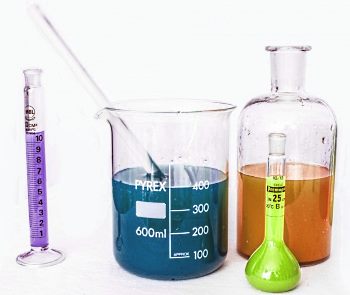property>molar concentration
What is Molar Concentration?

In Chemistry, the molar concentration or molarity of a solute is the measure of its concentration within a given volume of some kind of solution. Molarity is also the concentration of any molecular, ionic, or atomic species within some specified volume. The SI units for molarity are given as mol/m3. The molarity of a substance is given by the following mathematical equation:
c = n/V = N/(NA*V) = C/NA
where c is the molarity of the substance, n is the amount of solute in moles, N is the number of molecules in a given volume V, V is the volume being measured, C is the number concentration, and NA is Avogadro’s number (6.023*1023 mol-1). Each of these three equations is a way of arriving at the molar concentration of a given substance with whichever variables one is likely to have at hand to work with.
For non-thermodynamic applications in chemistry, the molarity of a substance can be a useful measure. To prepare a 200 millilitre solution of salt water (NaCl) with a molarity of 2 mol/m3, for example, we would calculate the amount of NaCl necessary (in grams) to add to the water. Because NaCl has a molar mass of 58 grams/mol, we do the following calculation:
((2 moles * 58 g/mol)*(200 ml))/1000ml = 23.2 grams
We now know how much salt to add to a solution to get the desired molarity of 2 mol/m3. To get the perfect concentration, we take approximately 160 ml of water, add 23.2 grams of salt, and then add water until the volume of the entire solution reaches 200 ml. This is one example of how to use the above equations to prepare a solution.
In thermodynamics the molar concentration of a substance is not as useful because the volume of solutions is somewhat dependent on temperature. This dependence is often mitigated by the introduction of temperature correction factors or by using a measure of concentration that is not temperature dependent such as molality.
The molality of a solution is a measure of the number of moles of solute per kilogram of solvent. Notice that there is no mention of volume in the definition of molality. Because there is no relationship to volume, there is also no temperature dependence to be taken from the ideal gas law:
PV = nRT.
where P is the pressure, V is the volume, n is the number of moles of a substance, R is the gas constant, and T is temperature. Solving for V, we get:
V = nRT/P
So we can see the clear temperature dependence of volume.
This said, there are certain cases in which the molality of a solution will align with the molarity of the solution. Most aqueous solutions at room temperature have this correlation because chemicals that are dissolved in water do not increase the volume of the solution by a significant amount (think of solute molecules fitting into the nooks and crannies between water molecules for a reason why). Once a solution becomes saturated, this is no longer the case. After the saturation point, any extra molecules will no longer dissolve and will therefore significantly contribute to the volume of the total solution.